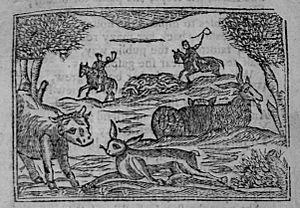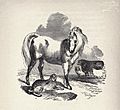The Hare and many friends facts for kids
The Hare and many friends is a famous story from a book of fables written by John Gay in 1727. It's about a hare who thinks she has many friends among the farm animals. But when she needs help, she finds out who her true friends are. The story shows that not all friendships are strong or reliable.
The fable tells how the hare lives happily with animals like horses, cows, and goats. One day, she hears the sounds of a hunt. She gets very scared and runs until she is tired. She asks each of her animal friends for help to escape the hunters. But every friend gives her an excuse. The last one, a young calf, simply says goodbye as the hunters arrive.
This poem was very popular for about 150 years. However, later on, a simpler version of the story appeared in books of Aesop's Fables. Because of this, many people forgot that John Gay was the original author.
Contents
The Fable's Journey Through Time
How the Story Started
John Gay wrote "The Hare and many friends" as the last poem in his first book of fables. He wrote these fables in 1727 to teach Prince William, Duke of Cumberland. After the book came out, John Gay hoped to get a good job from the royal family, but he didn't.
His friends then spread a story that the fable was about Gay's own life. For example, Jonathan Swift wrote that Gay, like the hare, waited for many years at court only to be let down. The correct title of the fable is "The Hare and many friends." But because of this story about Gay's bad luck, people often mistakenly called it "The Hare with many friends." This mistake was repeated in many books, like one written by David Erskine Baker in 1764.
A Popular Tale
John Gay's Fables became very popular and were printed many times. They were even "translated into every European language," including a Latin version. "The Hare and many friends" was a special favorite. It was often put into other collections of stories.
It also became a popular piece for people to recite. William Cowper was known for performing it as a child in the 1730s. Later, in the late 1700s, Catherine Morland, a character in Jane Austen's book Northanger Abbey, learned it very quickly.
What the Fable Means
The fable starts with a thought, much like other famous fables:
-
- Friendship, like love, is but a name,
- Unless to one you stint the flame.
This means that friendship, like love, isn't real unless you focus on just a few people. Some readers in the early 1800s didn't understand the gentle humor in these lines. One person wrote that this idea didn't match what they knew about friendship. Another person, a vicar's wife, wrote her own verses to explain that "Friendship and love are better thus defined."
Becoming an "Aesop's Fable"
Over time, John Gay's poem started appearing in collections of Aesop's Fables. For example, in Samuel Howitt's book from 1811, "The Hare and many friends" was included, but it didn't say who wrote it. The same thing happened in an 1875 collection of Aesop's fables.
A few years later, in 1894, Joseph Jacobs retold the story in his own words. He called it "The Hare with many friends." He gave it the moral: "He that has many friends has no friends." This idea came from Gay's original lines: "'Tis thus in friendships; who depend/ On many, rarely find a friend." Jacobs also changed the ending so the hare escapes the hunters.
Even though a small note in Jacobs's book said the fable was originally Gay's, many later printings of this version said Aesop wrote it. This is why many people today think "The Hare and many friends" is an Aesop's fable.
Illustrations of the Fable
Many talented artists have drawn pictures for "The Hare and many friends." These include Thomas Bewick and possibly his brother John. Another artist was Bewick's student, William Harvey.
Samuel Howitt, who was famous for drawing animals, also made pictures for the fable. He created copperplate prints that were sold on their own and in his book A New Work of Animals. Ernest Griset made drawings that sometimes had a funny, political meaning.
Most of the pictures show the tired hare lying near one of its friends who is making excuses. If the friend is the calf, you can often see hunters riding in the background.








